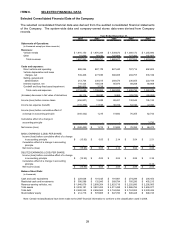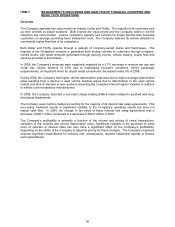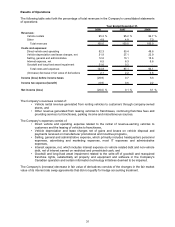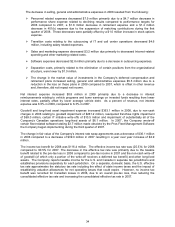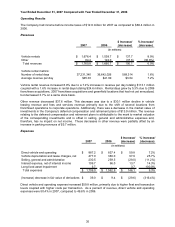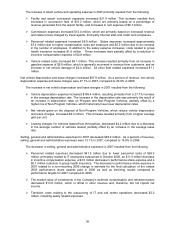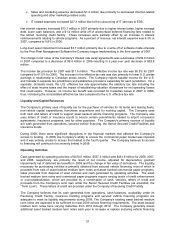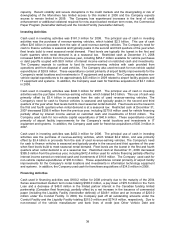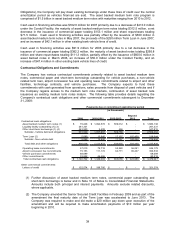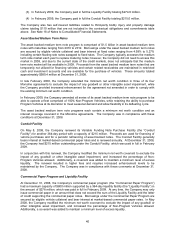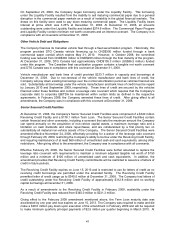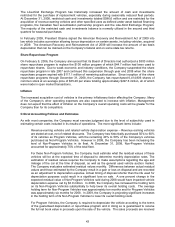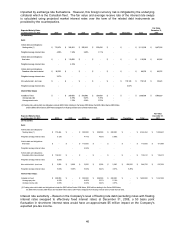Thrifty Car Rental 2008 Annual Report Download - page 40
Download and view the complete annual report
Please find page 40 of the 2008 Thrifty Car Rental annual report below. You can navigate through the pages in the report by either clicking on the pages listed below, or by using the keyword search tool below to find specific information within the annual report.capacity. Recent volatility and severe disruptions in the credit markets and the downgrading or risk of
downgrading of the Monolines has limited access to this market in 2008 and the Company expects
access to remain limited in 2009. The Company has experienced increases in the level of credit
enhancement or additional collateral required for new asset backed medium term notes, the Commercial
Paper Program (hereinafter defined) and the Conduit Facility (hereinafter defined).
Investing Activities
Cash used in investing activities was $161.3 million for 2008. The principal use of cash in investing
activities was the purchase of revenue-earning vehicles, which totaled $2.3 billion. This use of cash
offset $2.6 billion in proceeds from the sale of used revenue-earning vehicles. The Company’s need for
cash to finance vehicles is seasonal and typically peaks in the second and third quarters of the year when
fleet levels build to meet seasonal rental demand. Fleet levels are typically the lowest in the first and
fourth quarters when rental demand is at a seasonal low. Restricted cash at December 31, 2008
increased $463.6 million from the previous year, including $454.7 million available for vehicle purchases
or debt payoffs coupled with $8.9 million of interest income earned on restricted cash and investments.
The Company expects to continue to fund its revenue-earning vehicles with cash provided from
operations and from disposal of used vehicles. The Company also used net cash for non-vehicle capital
expenditures of $28.9 million. These expenditures consist primarily of airport facility improvements for the
Company’s rental locations and investments in IT equipment and systems. The Company estimates non-
vehicle capital expenditures to be approximately $25 million in 2009 related to airport facility projects and
IT equipment and systems. In addition, the Company used cash for franchise acquisitions of $2.1 million
in 2008.
Cash used in investing activities was $446.3 million for 2007. The principal use of cash in investing
activities was the purchase of revenue-earning vehicles, which totaled $4.0 billion. This use of cash was
primarily offset by $3.4 billion in proceeds from the sale of used revenue-earning vehicles. The
Company’s need for cash to finance vehicles is seasonal and typically peaks in the second and third
quarters of the year when fleet levels build to meet seasonal rental demand. Fleet levels are the lowest in
the first and fourth quarters when rental demand is at a seasonal low. Restricted cash at December 31,
2007 decreased $256.8 million from the previous year, including $270.8 million used for vehicle financing
partially offset by interest income earned on restricted cash and investments of $14.0 million. The
Company used cash for non-vehicle capital expenditures of $40.6 million. These expenditures consist
primarily of airport facility improvements for the Company’s rental locations and investments in IT
equipment and systems. In addition, the Company used cash for franchise acquisitions of $30.3 million in
2007.
Cash used in investing activities was $452.3 million for 2006. The principal use of cash in investing
activities was the purchase of revenue-earning vehicles, which totaled $4.2 billion, and was primarily
offset by $3.4 billion in proceeds from the sale of used revenue-earning vehicles. The Company’s need
for cash to finance vehicles is seasonal and typically peaks in the second and third quarters of the year
when fleet levels build to meet seasonal rental demand. Fleet levels are the lowest in the first and fourth
quarters when rental demand is at a seasonal low. Restricted cash at December 31, 2006 decreased
$395.5 million from the previous year, including $412.4 million used for vehicle financing partially offset by
interest income earned on restricted cash and investments of $16.9 million. The Company used cash for
non-vehicle capital expenditures of $35.8 million. These expenditures consist primarily of airport facility
improvements for the Company’s rental locations and investments in information technology equipment
and systems. In addition, the Company used cash for franchisee acquisitions of $34.5 million in 2006.
Financing Activities
Cash used in financing activities was $180.2 million for 2008 primarily due to the maturity of the 2004
Series asset backed medium term notes totaling $500.0 million, a pay down of $70.6 million in the Term
Loan and a decrease of $49.0 million in the limited partner interest in the Canadian funding limited
partnership (Canadian fleet financing), partially offset by a net increase in the issuance of commercial
paper (including the Liquidity Facility (hereinafter defined)) of $249.1 million and an increase of $203.0
million under the Conduit Facility. In 2009, the Company paid off all outstanding amounts under the
Conduit Facility and the Liquidity Facility totaling $215.0 million and $274.9 million, respectively. Due to
non-renewal of the vehicle manufacturer and bank lines of credit (see Other Vehicle Debt and
38


